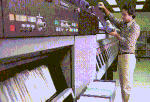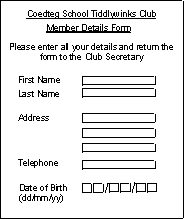| Data Capture | ||||
|
All data must come from somewhere. Collecting data from the real world is
called data capture.
Data must be precise and structured before a computer can process it. Many businesses now use ICT methods to capture and process data.
|
||||
| Data Capture Forms
There are many occasions when we are asked to fill in forms. These may be on paper or on screen. The design of data capture forms is important, because ..
Data is often entered in boxes - one letter in each box. This forces the person to write slowly and precisely. Capital letters are usually insisted upon.
|
||||
| On-screen
forms on a computer are often used for copying the data from paper forms.
The advantage of on-screen forms is that data can be validated as it is entered. This means the data is checked to make sure it is acceptable data. On-screen forms can limit user input by using drop-down boxes. Only one of a number of options can be selected...Like this one... |
Copying data from paper forms onto a computer is called transcription of data. |
|||
|
Gender : |
||||
Automated Data Capture There are some methods of data capture which eliminate human intervention:
|
||||
 An MICR reader can input data from thousands of bank cheques very quickly. |
||||


